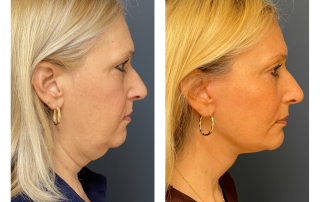Scars:
Definition
Plastic surgery is all about modifying the shape. As a matter of fact, the word “plastic” comes from the Greek “plastikos,” which means form. In order to modify the shape of the face or body, we often have to make incisions into the skin to either remove excess skin or access layers beneath it. When we suture the skin back together, the healing process begins. First, the two sides are joined by a glue-like material that the body forms, called a fibrin clot. We then have a period of inflammation and proliferation that allows microscopic blood vessels to grow from side to side. The clot is gradually removed and replaced by collagen fibers that give the wound more strength and prevent separation. By about six weeks, most of the skin’s strength is restored. This is why I tell my patients to be very careful not to distract or pull on the scars until the healing is complete. In plastic surgery, we encourage better healing by pulling together the deep layers of skin with dissolving sutures and approximating the edges carefully to minimize the body’s work and make the healing happen faster and better. Regardless of all our efforts, we must accept that every cut we make in the body will result in a scar. So the scar is the price we pay for a healed wound.
Prevention.
What do I do to make the scar not be visible or be minimally visible, and what makes some people heal so well and not have a visible scar? Now, let’s talk about what makes a scar visible. A great scar would look like a vey thin line in the skin that is not raised, and not red or white or dark. This type of healing is ideal and happens most frequently in the face and eyelids when all efforts have been made to make the wound heal better. The skin has natural tension lines called Langer’s lines. We make every effort to make the scar that we created follow these lines. We also try to hide the scars. For example, when I do a facelift, I place the scar in the natural creases of the skin and behind the ear cartilages. When the scars are by the hairlines, I would cut the hair in a beveled fashion so that the hair would grow through the scar and hide it. In the breast, we keep the scars under the breast and around the areolae as much as possible. In the abdomen, we keep the scars where they could be covered by a bikini, etc. The techniques of skin closure respect three principles: 1) Avoid unnecessary tension in the closure. 2) Absorb tension from the skin by keeping the tension in the deep layers. 3) Meticulous edge-to-edge approximation with no tension. Adhering to these principles and placing the scar in creases, following the Langer’s lines, and hiding as much of the scars as possible will result in the greatest healing of most scars. We often use other preventative measures after surgery like avoiding sun exposure, sunscreens when the incisions are healed, silicone sheets or tapes, silicone gels, paper tapes, onion extract creams, etc.
Treatment of visible scars
Now let’s talk about what makes a scar visible despite all these efforts in certain cases. The visible scars are either hypertrophic, atrophic, or keloid. Hypertrophic scars are raised, red, and wide. They can also be itchy or tender. Atrophic scars are wide and depressed. They can be pigmented or white. The keloids are abnormal growths of collagen fibers that sometimes grow into tumor-like masses. There is often a genetic factor contributing to keloid scar formation, as this is most common amongst African Americans and other darker-skinned people. We talked about the prevention of scars, but what should be done if they happen regardless? The hypertrophic scars could be injected with steroids like triamcinolone, 5-FU, silicone, and pressure, angiotensin receptor blockers, dupilumab, bleomycin, pentoxifylline, laser therapy, and even cryotherapy inside the keloids. Many of these measures are used in combination. Surgical removal and injection treatments are also combined in worse cases. The first thing to do if you notice a visible scar is to talk to your plastic surgeon and plan the correct treatment early. Scarring is the most enigmatic aspect of plastic surgery; therefore, the worst thing you could do is try to research it yourself and fall into the wrong hands and get a treatment that could give you worse results.


